Field Investigations and Service Life Assessment of Geosynthetic Filters in Tidally Influenced Revetments in Cases of Ochre Clogging
Abstract
:1. Introduction
2. Study Areas and Methods
2.1. Study Area: Ems Estuary
2.2. Study Area: Weser Estuary
2.3. Research Programme
2.4. Groundwater Investigations
2.5. River Water Investigations
2.6. Aquifer Material Sampling
2.7. Granular Filter Sampling
2.8. Geotextile Filter Sampling
3. Results
3.1. Examination of River Water and Groundwater
- a: 0.5 × (hMHW−hMLW);
- d: hMLW−hMLWS;
- hMHW: mean high water level;
- hMLW: mean low water level;
- hMLWS: mean low water spring tide level.
3.2. Examination of Revetment Components
3.3. Aquifer Material
3.4. Granular Filter
3.5. Geotextile Filter
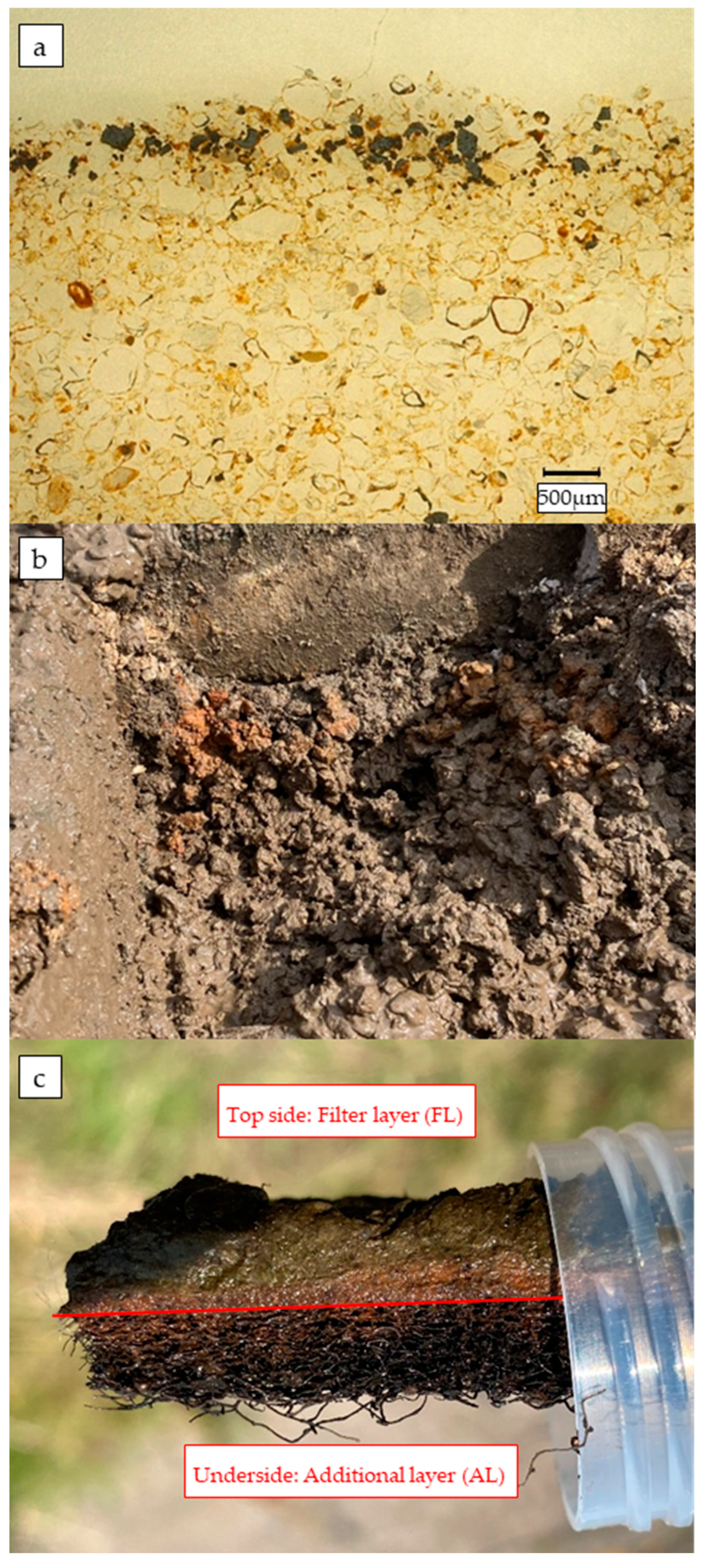
4. Discussion
4.1. Environmental Conditions of Filters
4.2. River Water
4.3. Groundwater
4.4. Aquifer Material
4.5. Armour Layer
- γA: safety factor for buoyancy;
- ΔhW: difference in water level (Equation (1));
- γW: weight density of water;
- β: slope angle.
4.6. Ochre Clogging in Granular Filters
4.7. Formation and Characteristics of Ochre-Clogging Products in Geotextile Filters
4.8. Application of Geotextile Filters in the Case of Ochre Clogging Tendency
5. Conclusions and Prospects
Author Contributions
Funding
Data Availability Statement
Acknowledgments
Conflicts of Interest
References
- Federal Waterways Engineering and Research Institute. BAWMerkblatt Anwendung von Regelbauweisen für Böschungs- und Sohlensicherungen an Binnenwasserstraßen (MAR); Federal Waterways Engineering and Research Institute: Karlsruhe, Germany, 2008. [Google Scholar]
- German Coastal Engineering Research Council. Die Küste, Heft 88, EAK 2002, Empfehlungen für Küstenschutzwerke, 3. Korrigierte Ausgabe 2020; German Coastal Engineering Research Council, Ed.; German Coastal Engineering Research Council: Hamburg, Germany, 2020. [Google Scholar] [CrossRef]
- Tophoff, L.; Finklenburg, B.; Schriewer, E.-L.; Schüttrumpf, H.; Heimbecher, F. Assessment of the functionality of geotextile and granular filter systems in hydraulic engineering in case of iron ochre clogging tendency. Geotext. Geomembr. 2024, 52, 465–478. [Google Scholar] [CrossRef]
- Correia, L.; Ehrlich, M.; Mendonca, M.B.; Keim, C.N. Laboratory studies on ochre formation and removal from geotextile filters. Can. Geotech. J. 2023, 60, 31–43. [Google Scholar] [CrossRef]
- Weidner, C. Experimental Modelling and Prevention of Chemical Fe-Clogging in Deep Vertical Wells for Open-Pit Dewatering. Ph.D. Thesis, RWTH Aachen, Aachen, Germany, 2015. [Google Scholar]
- Abromeit, H.-U. Revetment damage as a result of geotextile colmation by flocculated ochreous products and possible repair methods. In Proceedings of the ICG 7, Geosynthetics International Conference, Nice, France, 22–27 September 2002; pp. 1085–1088. [Google Scholar]
- van Veldhuijzen Zanten, R.; Thabet, R. Investigation on long-Term Behavior of Geotextiles in Bank Protection Works. In Proceedings of the Second International Conference on Geotextiles, Las Vegas, NV, USA, 1–6 August 1982. [Google Scholar]
- Weidner, C.; Henkel, S.; Lorke, S.; Rüde, T.R.; Schüttrumpf, H.; Klauder, W. Experimental Modelling of Chemical Clogging Processes in Dewatering Wells. Mine Water Environ. 2012, 31, 242–251. [Google Scholar] [CrossRef]
- Tophoff, L.; Kreyenschulte, M.; Schüttrumpf, H.; Heimbecher, F. Ochre clogging of hydraulic engineering filter systems: State of the science and necessary investigations. Grund. Z. Fachsekt. Hydrogeol. 2022, 27, 295–308. [Google Scholar] [CrossRef]
- Houben, G.; Treskatis, C. Regenerierung und Sanierung von Brunnen: Technische und Naturwissenschaftliche Grundlagen der Brunnenalterung und Möglicher Gegenmaßnahmen, 3rd ed.; Vulkan-Verlag: Essen, Germany, 2020; ISBN 3835673882. [Google Scholar]
- Kuntze, H. Verockerungen: Diagnose und Therapie; Nach KWK-Versuchen 1956–1976; Parey: Hamburg, Germany, 1978; ISBN 9783490032973. [Google Scholar]
- Szewzyk, U.; Szewzyk, R.; Schmidt, B.; Braun, B. Neutrophilic Iron-Depositing Microorganisms. In Biofilm Highlights; Flemming, H.-C., Wingender, J., Szewzyk, U., Eds.; Springer: Berlin/Heidelberg, Germany, 2011; pp. 63–79. ISBN 978-3-642-19939-4. [Google Scholar]
- de Mendonca, M.B.; Ehrlich, M.; Cammarota, M.C. Conditioning factors of iron ochre biofilm formation on geotextile filters. Can. Geotech. J. 2003, 40, 1225–1234. [Google Scholar] [CrossRef]
- Liu, S.; Wang, Y.; Di, F. Influence of polyurethane foam on chemical clogging of nonwoven geotextile and tailings caused by ferrous iron. Text. Res. J. 2021, 91, 1094–1103. [Google Scholar] [CrossRef]
- Cao, W.; Yan, G.; Hofmann, H.; Scheuermann, A. State of the Art on Fe Precipitation in Porous Media: Hydrogeochemical Processes and Evolving Parameters. JMSE 2024, 12, 690. [Google Scholar] [CrossRef]
- Federal Waterways Engineering and Research Institute. BAWMerkblatt Anwendung von Geotextilen Filtern an Wasserstraßen (MAG); Federal Waterways Engineering and Research Institute: Karlsruhe, Germany, 2021. [Google Scholar]
- Elbracht, J.; Meyer, R.; Reutter, E. Hydrogeologische Räume und Teilräume in Niedersachsen, 3rd ed.; Landesamt für Bergbau, Energie und Geologie: Hannover, Germany, 2017. [Google Scholar] [CrossRef]
- Federal Waterways and Shipping Administration. Wasserstandsdaten für den Pegel Rhede (Ems) Zwischen den Jahren 2013 bis 2022; Measurement Stations: DEK-km 217.86: Meppen, Germany, 2024; Unpublished. [Google Scholar]
- Niedersachsen. Übersichtskarte Niedersachsen. Available online: www.niedersachsen.de (accessed on 4 June 2024).
- Federal Waterways and Shipping Administration. Wasserstandsdaten für den Pegel Elsfleth (Weser) Zwischen den Jahren 2013 bis 2022; Measurement Stations: Weser-km 33.33: Bremen, Germany, 2023; Unpublished. [Google Scholar]
- DIN EN ISO 17892-4:2017-04; Geotechnische Erkundung und Untersuchung -Laborversuche an Bodenproben -Teil 4: Bestimmung der Korngrößenverteilung (ISO 17892-4:2016); Deutsche Fassung EN ISO 17892-4:2016. Beuth Verlag GmbH: Berlin, Germany, 2016.
- DIN EN ISO 17892-11:2021-03; Geotechnische Erkundung und Untersuchung -Laborversuche an Bodenproben -Teil 11: Bestimmung der Wasserdurchlässigkeit (ISO 17892-11:2019); Deutsche Fassung EN ISO 17892-11:2019. Beuth Verlag GmbH: Berlin, Germany, 2019.
- DIN EN 17685-1:2023-04; Erdarbeiten -Chemische Prüfverfahren -Teil 1: Bestimmung des Glühverlusts; Deutsche Fassung EN 17685-1:2023. Beuth Verlag GmbH: Berlin, Germany, 2023.
- DIN EN ISO 17294-2:2017-01; Wasserbeschaffenheit -Anwendung der Induktiv Gekoppelten Plasma-Massenspektrometrie (ICP-MS) -Teil 2: Bestimmung von Ausgewählten Elementen Einschließlich Uran-Isotope (ISO 17294-2:2016); Deutsche Fassung EN ISO 17294-2:2016. Beuth Verlag GmbH: Berlin, Germany, 2016.
- ASTM D 5887; Test Method for Measurement of Index Flux through Saturated Geosynthetic Clay Liner Specimens Using a Flexible Wall Permeameter. ASTM International: West Conshohocken, PA, USA, 2016.
- DIN EN ISO 11058:2019-09; Geotextilien und Geotextilverwandte Produkte -Bestimmung der Wasserdurchlässigkeit normal zur Ebene, ohne Auflast (ISO 11058:2019); Deutsche Fassung EN ISO 11058:2019. Beuth Verlag GmbH: Berlin, Germany, 2019.
- DIN EN ISO 9864:2005-05; Geokunststoffe -Prüfverfahren zur Bestimmung der Flächenbezogenen Masse von Geotextilien und Geotextilverwandten Produkten (ISO 9864:2005); Deutsche Fassung EN ISO 9864:2005. Beuth Verlag GmbH: Berlin, Germany, 2005.
- Parada, A.E.; Needham, D.M.; Fuhrman, J.A. Every base matters: Assessing small subunit rRNA primers for marine microbiomes with mock communities, time series and global field samples. Environ. Microbiol. 2016, 18, 1403–1414. [Google Scholar] [CrossRef]
- Bakenhus, I.; Jongsma, R.; Michler-Kozma, D.; Hölscher, L.; Gabel, F.; Holert, J.; Philipp, B. A domesticated photoautotrophic microbial community as a biofilm model system for analyzing the influence of plastic surfaces on invertebrate grazers in limnic environments. Front. Microbiol. 2023, 14, 1238913. [Google Scholar] [CrossRef] [PubMed]
- The Committee for Waterfront Structures of the German Port Technology Association and the German Geotechnical Society. Recommendations of the Committee for Waterfront Structures Harbours and Waterways: EAU 2020, 10th ed.; Wilhelm Ernst & Sohn Verlag fur Architektur und Technische: Newark, NJ, USA, 2024; ISBN 978-3-433-03392-0. [Google Scholar]
- Lower Saxony Water Management, Coastal and Nature Protection Agency. Grundwasserstandsdaten der Gütemessstellen 101 Aschendorf und 247 Borsumer Berge I im Zeitraum 2013–2022; Measurement Stations: Rhede (Ems), Meppen, Germany, 2023; Unpublished. [Google Scholar]
- Lower Saxony Water Management, Coastal and Nature Protection Agency. Grundwasserstandsdaten der Gütemessstelle UWO 164 N 19 Neuenkirchen im Zeitraum 2013–2022; Measurement Stations: Neuenkirchen (Weser), Bremen, Germany, 2023; Unpublished. [Google Scholar]
- Federal Waterways Engineering and Research Institute. BAWMerkblatt Anwendung von Kornfiltern an Bundeswasserstraßen (MAK); Federal Waterways Engineering and Research Institute: Karlsruhe, Germany, 2013. [Google Scholar]
- Talke, S.A.; de Swart, H.E.; Schuttelaars, H.M. Feedback between residual circulations and sediment distribution in highly turbid estuaries: An analytical model. Cont. Shelf Res. 2009, 29, 119–135. [Google Scholar] [CrossRef]
- Federal Waterways Engineering and Research Institute. Gutachten zu Schäden und Instandsetzungsmaßnahmen an den Deckwerken der Oberen Tideems; BAW-Nr. 93 51 3574; Federal Waterways Engineering and Research Institute: Karlsruhe, Germany, 1993; Unpublished. [Google Scholar]
- Correia, L.; Ehrlich, M.; Mendonca, M. The effect of submersion in the ochre formation in geotextile filters. Geotext. Geomembr. 2017, 45, 1–7. [Google Scholar] [CrossRef]
- Hölting, B.; Coldewey, W.G. Hydrogeologie; Spektrum Akademischer Verlag: Heidelberg, Germany, 2013; ISBN 978-3-8274-2353-5. [Google Scholar]
- Hanert, H.H. The Genus Gallionella. In The Prokaryotes; Dworkin, M., Falkow, S., Rosenberg, E., Schleifer, K.-H., Stackebrandt, E., Eds.; Springer: New York, NY, USA, 2006; pp. 990–995. ISBN 978-0-387-25497-5. [Google Scholar]
- Hallbeck, L.; Pedersen, K. The Family Gallionellaceae. In The Prokaryotes; Rosenberg, E., DeLong, E.F., Lory, S., Stackebrandt, E., Thompson, F., Eds.; Springer: Berlin/Heidelberg, Germany, 2014; pp. 853–858. ISBN 978-3-642-30196-4. [Google Scholar]
- Department of the Interior, Bureau of Reclamation. Chapter 7: Riprap Slope Protection: DS-13(7)-2.1. In Design Standards No. 13, Embankment Dams; The United States Bureau of Reclamation: Washington, DC, USA, 2014. [Google Scholar]
- Department of the Interior, Bureau of Reclamation. Chapter 19: Geotextiles: DS-13(19)-1. In Design Standards No. 13, Embankment Dams; The United States Bureau of Reclamation: Washington, DC, USA, 2014. [Google Scholar]
- Chen, R.-H.; Ho, C.-C.; Chung, W.-B. The filtration mechanism and micro-observation of soil-geotextile systems under cyclic flows. J. GeoEng. 2008, 3, 101–112. [Google Scholar]
- Miszkowska, A.; Lenart, S.; Koda, E. Changes of Permeability of Nonwoven Geotextiles due to Clogging and Cyclic Water Flow in Laboratory Conditions. Water 2017, 9, 660. [Google Scholar] [CrossRef]
- Palmeira, E.M.; Remigio, A.F.; Ramos, M.L.; Bernardes, R.S. A study on biological clogging of nonwoven geotextiles under leachate flow. Geotext. Geomembr. 2008, 26, 205–219. [Google Scholar] [CrossRef]
- Northup, D.E.; Barns, S.M.; Yu, L.E.; Spilde, M.N.; Schelble, R.T.; Dano, K.E.; Crossey, L.J.; Connolly, C.A.; Boston, P.J.; Natvig, D.O.; et al. Diverse microbial communities inhabiting ferromanganese deposits in Lechuguilla and Spider Caves. Environ. Microbiol. 2003, 5, 1071–1086. [Google Scholar] [CrossRef] [PubMed]
- Gülay, A.; Çekiç, Y.; Musovic, S.; Albrechtsen, H.-J.; Smets, B.F. Diversity of Iron Oxidizers in Groundwater-Fed Rapid Sand Filters: Evidence of Fe(II)-Dependent Growth by Curvibacter and Undibacterium spp. Front. Microbiol. 2018, 9, 2808. [Google Scholar] [CrossRef] [PubMed]
- Giroud, J.; Luettich, S.; Richardson, G.; Zhao, A. Permeability of geotextile and granular filters. In Proceedings of the ICG 7, Geosynthetics International Conference, Nice, France, 22–27 September 2002; pp. 1065–1068. [Google Scholar]
- Federal Waterways Engineering and Research Institute. Schlussbericht zur Sanierung der Schäden am Plattendeckwerk Neuenkirchen bei Unterweser-km 29,7 und 32,2; BAW-Nr. 92-21.5313; Federal Waterways Engineering and Research Institute: Karlsruhe, Germany, 1998; Unpublished. [Google Scholar]
- Palmeira, E.M. Geotextile filters: From idealization to real behaviour (Giroud lecture). In Geosynthetics: Leading the Way to a Resilient Planet; Biondi, G., Cazzuffi, D., Moraci, N., Soccodato, C., Eds.; CRC Press: London, UK, 2023; pp. 3–45. ISBN 9781003386889. [Google Scholar]
- Shukla, S.K. (Ed.) Handbook of Geosynthetic Engineering: Geosynthetics and Their Applications, 2nd ed.; ICE Publishing: London, UK, 2012; ISBN 978-0-7277-4175-2. [Google Scholar]
- Heibaum, M. Geosynthetics for waterways and flood protection structures—Controlling the interaction of water and soil. Geotext. Geomembr. 2014, 42, 374–393. [Google Scholar] [CrossRef]
- Rüegger, R.; Hufenus, R. (Eds.) Bauen mit Geokunststoffen: Ein Handbuch für den Geokunststoff-Anwender; SVG: St. Gallen, Switzerland, 2003; ISBN 3952277401. [Google Scholar]
- Giroud, J. Development of criteria for geotextiles and granular filters. In Proceedings of the 9th International Conference on Geosynthetics, Guarujá, Brazil, 23–27 May 2010; pp. 45–64. [Google Scholar]
- Federal Waterways Engineering and Research Institute. BAWRichtlinie Prüfung von Geokunststoffen im Verkehrswasserbau (RPG); Federal Waterways Engineering and Research: Karlsruhe, Germany, 2021. [Google Scholar]


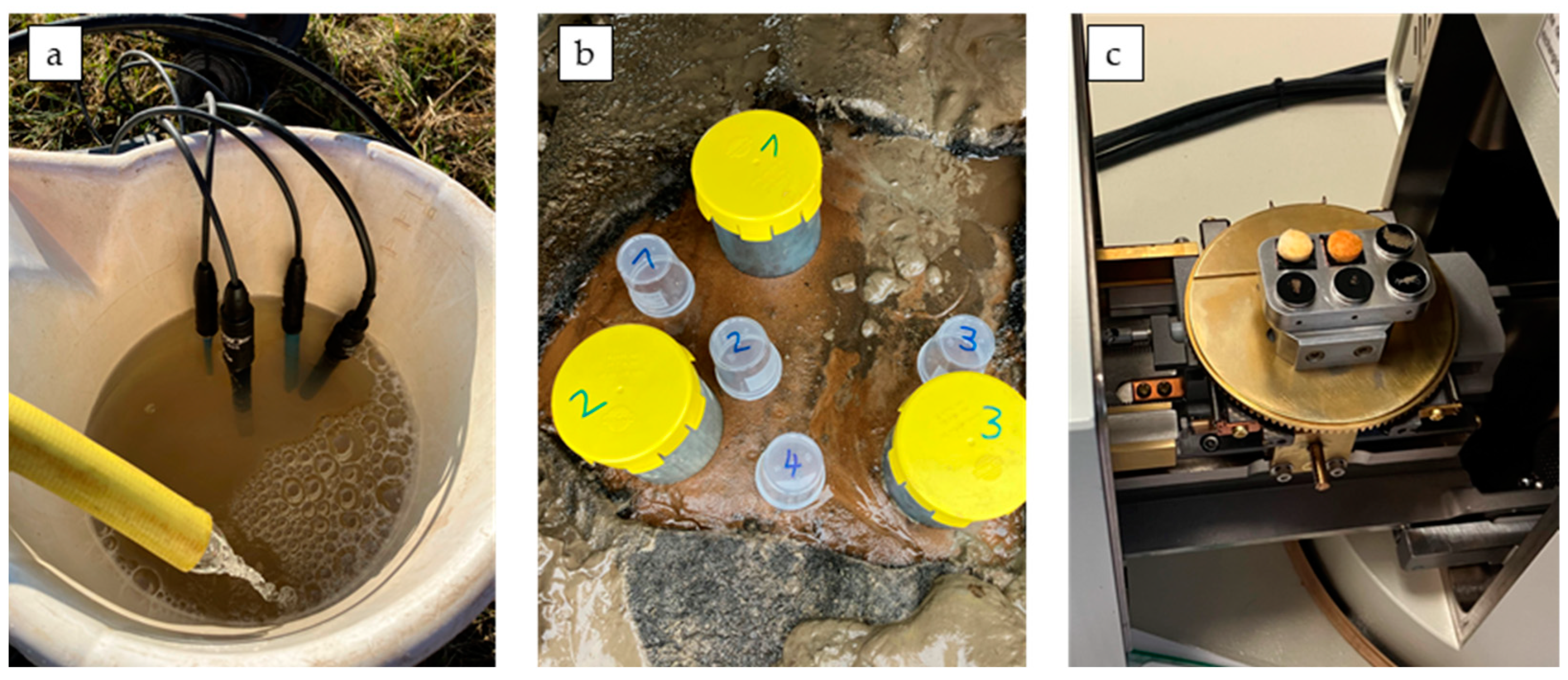
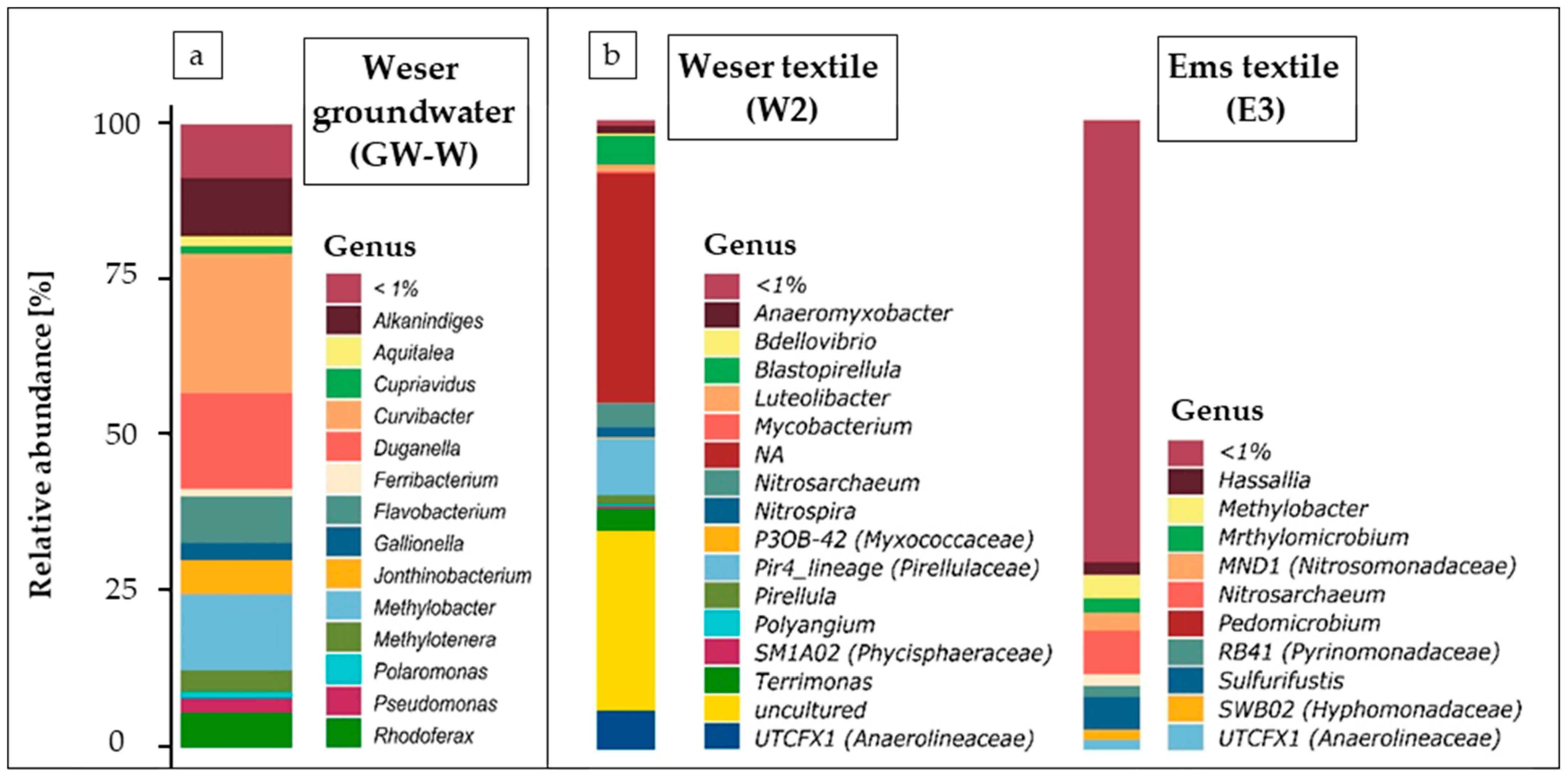

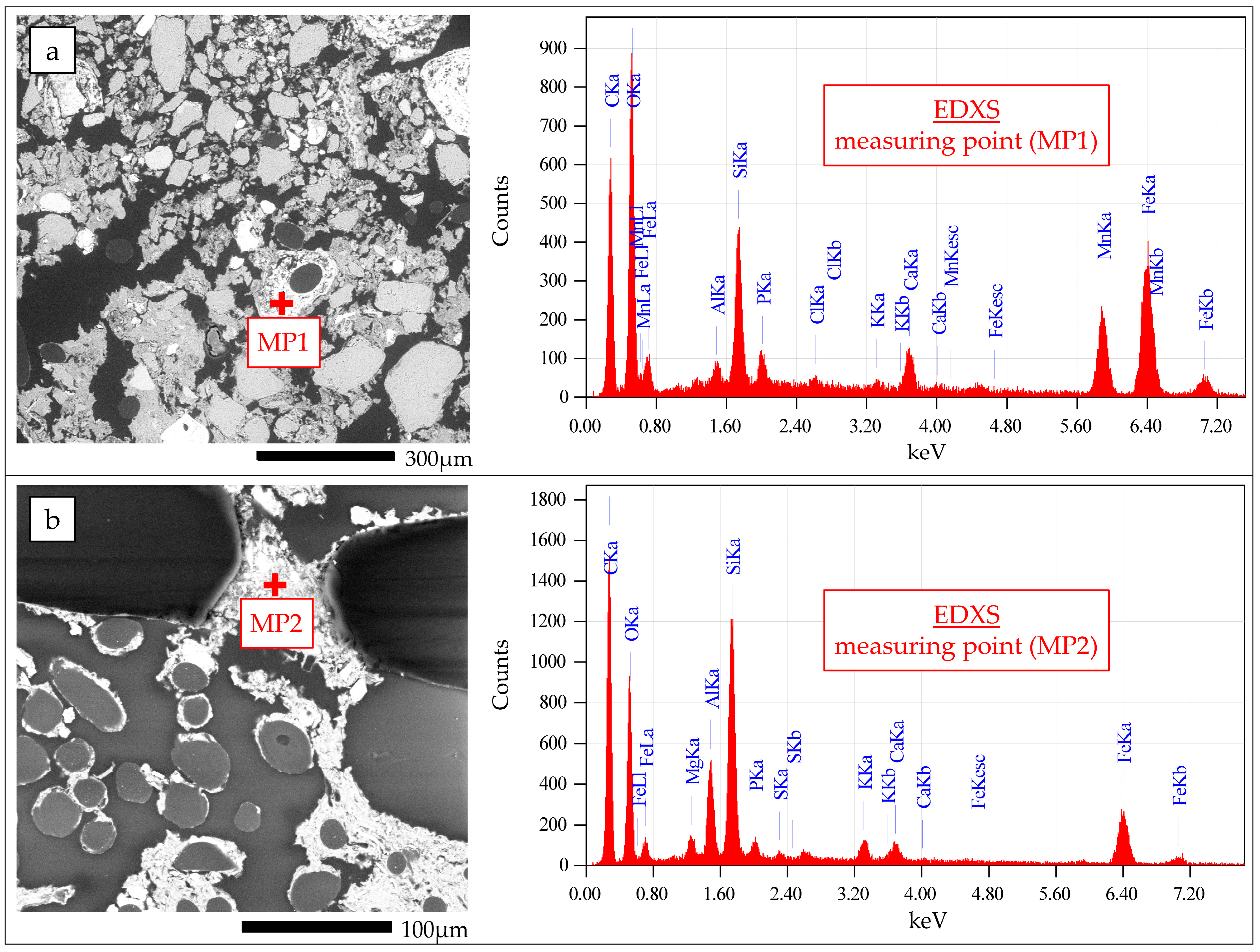
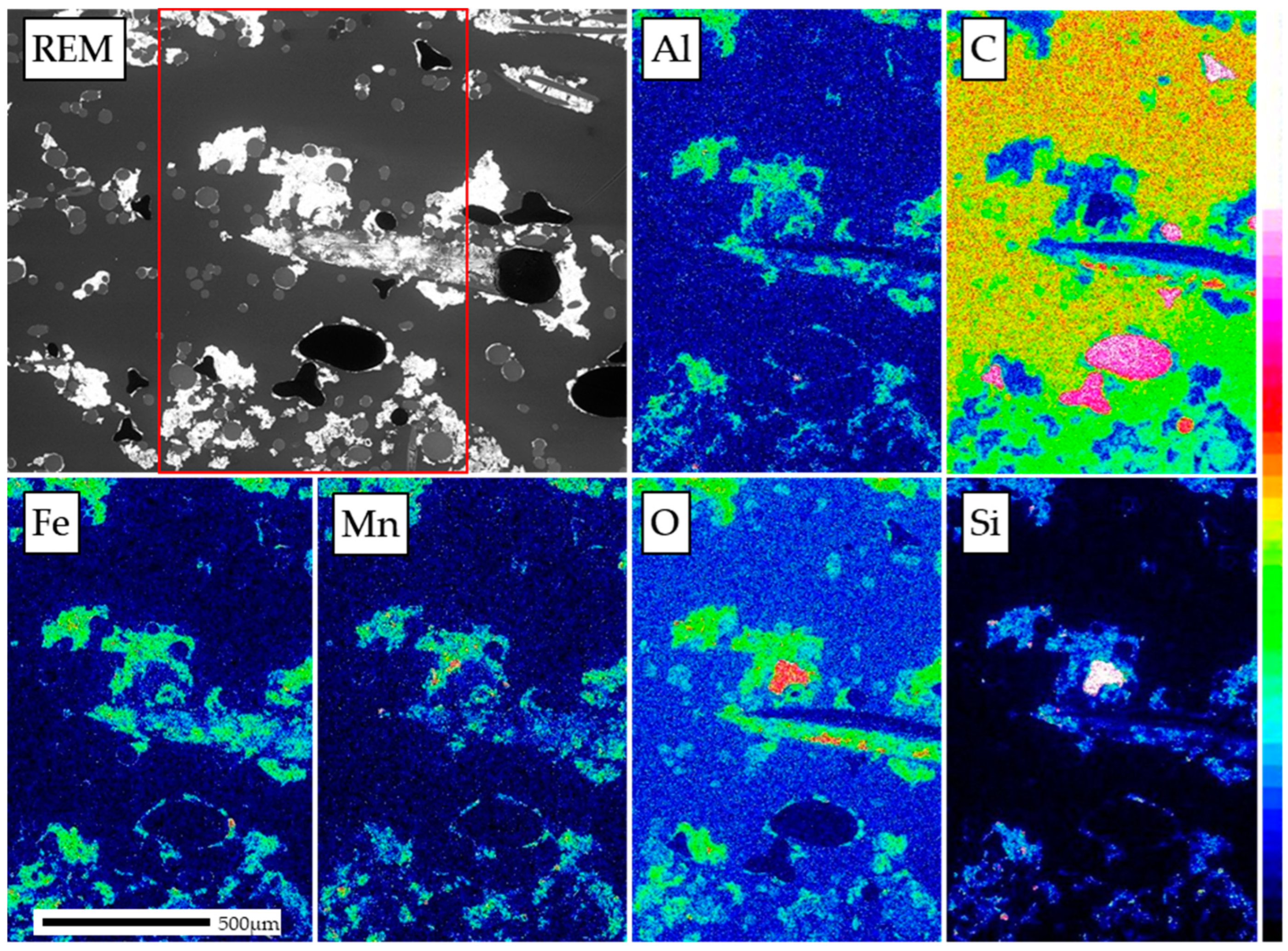
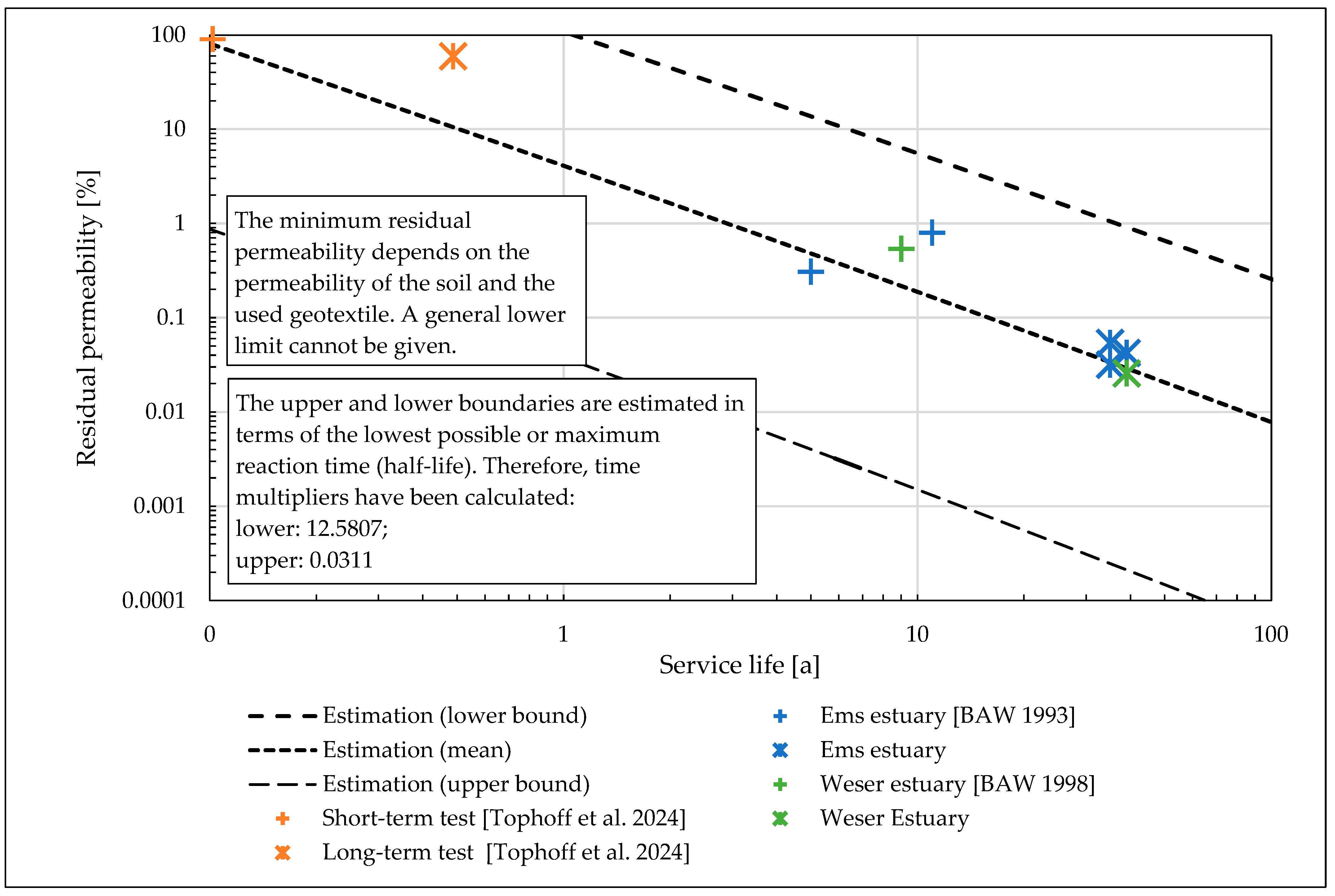
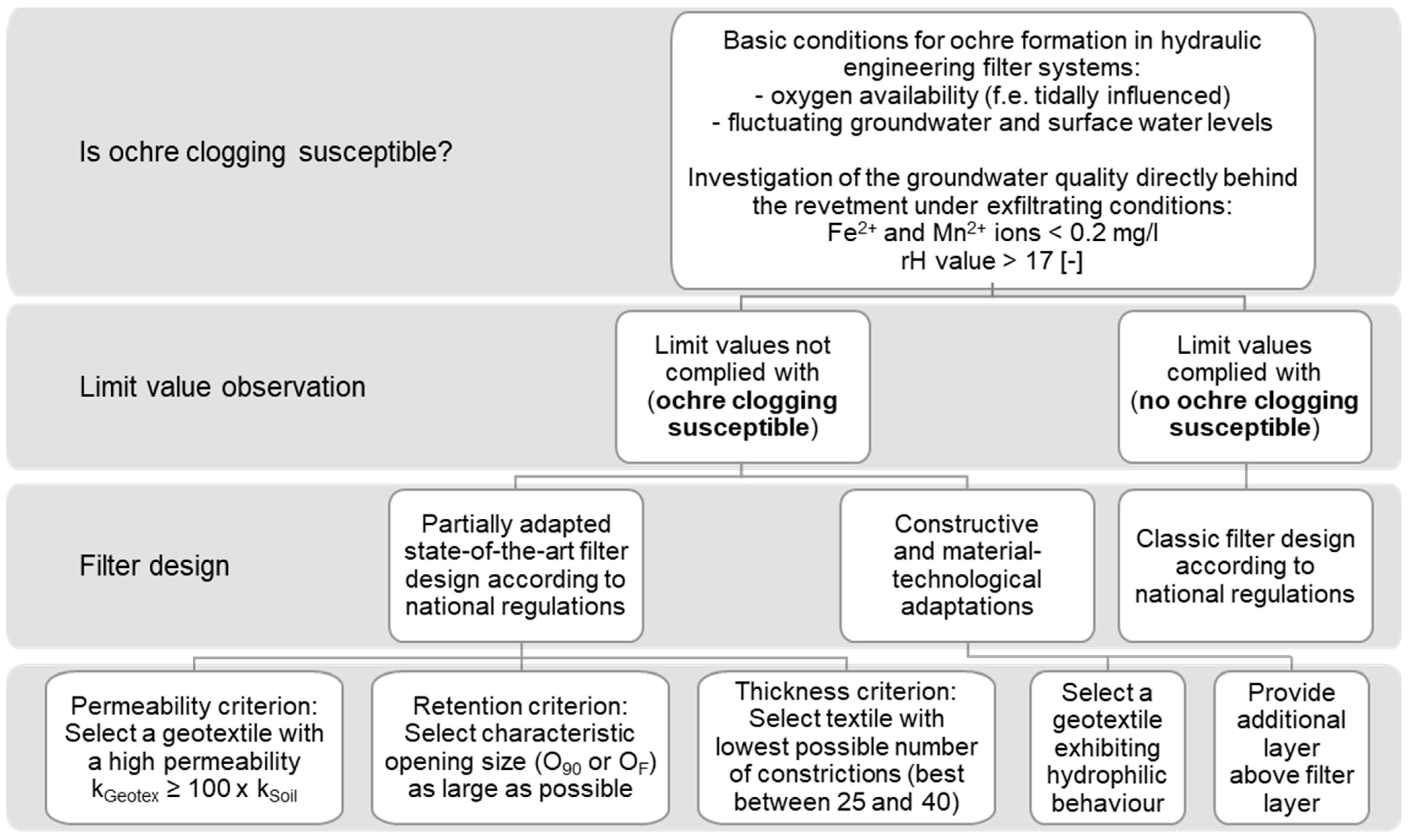
| Water Level | Tide Gauge Rhede (Ems) | Tide Gauge Elsfleth |
|---|---|---|
| MHW [MAMSL] | 1.96 | 2.19 |
| MLW [MAMSL] | −1.39 | −1.72 |
| Mn [m] | 3.35 | 3.91 |
| RD [h] | 3:21 | 5:50 |
| FD [h] | 9:03 | 6:35 |
| MLWS [MAMSL] | −1.52 | −1.84 |
| Station | Investigations |
|---|---|
| GW1-E, GW2-E, GW1.1-W, GW1.2-W, GW2.1-W, GW2.2-W (groundwater) |
|
| RW-E RW-W (river water) |
|
| E1, E2, E3, W1, W2 (aquifer material) |
|
| E1, E2, E3, W2 (geotextile filter) |
|
| W1 (granular filter) |
|
| Stations | No. of Sampling | |||
|---|---|---|---|---|
| 1 | 2 | 3 | 4 | |
| GW-E (all stations) | 6 May 2022 | 16 August 2022 | 29 October 2022 | 25 March 2023 |
| RW-E | ||||
| GW-W (all stations) | 4 May 2022 | 3 August 2022 | 14 November 2022 | 14 February 2023 |
| RW-W | ||||
| Stations | No. of Samplings | |||
|---|---|---|---|---|
| 1 | 2 | 3 | 4 | |
| GW1-E | 0.87 | 1.03 | 0.41 | 1.05 |
| GW2-E | 0.28 | 0.59 | 1.19 | −0.15 |
| GW1.1-W | 2.37 | 1.34 | 1.51 | 1.67 |
| GW1.2-W | −0.60 | 1.99 | 2.05 | 2.22 |
| GW2.1-W | n/a | 1.56 | 1.8 | 1.04 |
| GW2.2-W | n/a | 0.66 | 1.73 | 2.19 |
| all values in m | ||||
| Parameter | Unit | GW1-E | GW2-E | GW1.1-W | GW1.2-W | GW2.1-W | GW2.2-W | RW-E | RW-W |
|---|---|---|---|---|---|---|---|---|---|
| pH value | - | 6.8 ± 0 | 6.7 ± 0.1 | 7.0 ± 0 | 7.3 ± 0.3 | 7.3 ± 0.1 | 7.2 ± 0.1 | 7.7 ± 0.1 | 7.7 ± 0.4 |
| EH value | mV | 172.5 ± 51.2 | −8.5 ± 44.6 | 15.6 ± 85.5 | 43 ± 98.3 | 43 ± 92.4 | 27.5 ± 103.9 | 217.5 ± 22.8 | n/a |
| Temp. | °C | 11.3 ± 1.1 | 12.1 ± 1.9 | 12.1 ± 0.9 | 15.1 ± 2.8 | 14.8 ± 1.3 | 14.5 ± 4.1 | 14.5 ± 5.9 | 14.2 ± 5.9 |
| DO | mg/L | 3.3 ± 1.1 | 3.8 ± 1.6 | 0.9 ± 1.2 | 5.2 ± 2.8 | 3.8 ± 2.8 | 2.5 ± 1.6 | 9.2 ± 2.4 | 10.0 ± 2.1 |
| EC | µS/cm | 990 ± 108 | 862 ± 107 | 1730 ± 12 | 1743 ± 78 | 1347 ± 5 | 1697 ± 61 | 690 ± 58 | 1153 ± 263 |
| rH value | - | 19.7 | 13.1 | 14.6 | 16.1 | 16.1 | 15.4 | 23.0 | n/a |
| Fe2+ | mg/L | ≤0.1 ± 0 | 10.1 ± 5.6 | 25.4 ± 2.9 | 23.7 ± 5.7 | 11.9 ± 5.4 | 23.6 ± 1.4 | ≤0.1 ± 0 | ≤0.1 ± 0 |
| Fe3+ | mg/L | ≤0.1 ± 0 | ≤0.1 ± 0 | 1.1 ± 1.4 | 0.4 ± 0.3 | 0.6 ± 0.2 | 1.1 ± 0.9 | ≤0.1 ± 0 | ≤0.1 ± 0 |
| Fetot | mg/L | 0.1 ± 0 | 9.9 ± 5.2 | 26.3 ± 0.8 | 27.8 ± 6.0 | 10.4 ± 6.6 | 14.6 ± 7.8 | 38.3 ± 22.3 | 0.5 ± 0.7 |
| Mn2+ | mg/L | ≤0.1 ± 0 | 0.5 ± 0 | 4.4 ± 0.1 | 3.8 ± 0.5 | 2.9 ± 0 | 3.2 ± 0.3 | ≤0.1 ± 0 | ≤0.1 ± 0 |
| Mntot | mg/L | ≤0.1 ± 0 | 0.5 ± 0 | 4.5 ± 0 | 3.9 ± 0.4 | 2.9 ± 0.1 | 3.3 ± 0.2 | 1.7 ± 0.8 | ≤0.1 ± 0 |
| Na+ | mg/L | 56.0 ± 12.2 | 85.8 ± 23.1 | 89.1 ± 3.6 | 72.9 ± 6.6 | 117 ± 3.7 | 147 ± 2.2 | 44.5 ± 10.4 | 100.9 ± 34.6 |
| Cl− | mg/L | 82.5 ± 49.1 | 99.9 ± 38.7 | 151.8 ± 4.4 | 158.8 ± 9.2 | 219.0 ± 8.5 | 317.3 ± 20.9 | 82.5 ± 21.3 | 193.8 ± 60.1 |
| Nitrate | mg/L | 2.9 ± 1.8 | ≤0.1 ± 0 | ≤0.1 ± 0 | 0.2 ± 0.1 | ≤0.1 ± 0 | ≤0.1 ± 0 | 0.8 ± 0 | 2.6 ± 0.7 |
| DOC | mg/L | 5.6 ± 0 | 5.8 ± 0 | 11.9 ± 0.2 | 10.6 ± 0.7 | 5.3 ± 0.5 | 5.1 ± 0.8 | 8.6 ± 0 | 4.5 ± 0.7 |
| TOC | mg/L | 5.7 ± 0.1 | 5.9 ± 0.5 | 12.6 ± 0.6 | 17.2 ± 6.2 | 4.7 ± 1.3 | 5.7 ± 0.9 | 28.2 ± 18.1 | 10.3 ± 5.4 |
| Station | Date of Sampling | Year of Construction | Armour Layer | Filter | Aquifer Material |
|---|---|---|---|---|---|
| E1 | 17 August 2022 | 1987 | 45 cm sandstone riprap (weight per unit area: 550–600 kg) | Geotextile A | Sand, 0.1–0.5 mm |
| E2 | 17 August 2022 | 1983 | Geotextile B | Sand, 0.1–0.6 mm | |
| E3 | 23 November 2022 | 1987 | Geotextile B | Sand, 0.1–0.5 mm | |
| W1 | 04 August 2022 | Unknown | 22 cm reinforced concrete slabs + 10 cm drainage (weight per unit area: 670 kg) | Granular filter | Sand, 0.15–1.5 mm |
| W2 | 04 August 2022 | 1983/84 | Geotextile C | Sand, 0.15–1.5 mm |
| E1 | E2 | E3 | W1 | W2 | |
|---|---|---|---|---|---|
| Grain size [mm] | 0.1–0.5 | 0.15–1.5 | |||
| Coefficient of uniformity [Cu] | 2.1–2.4 | 2.2 | |||
| Hydraulic conductivity (kT,10 °C value) [m/s] | 1.2 × 10−5 | 4.5 × 10−5 | |||
| Loss on ignition (LOI) [%] | 0.4 | 0.3 | |||
| Dry density [g/cm3] | 1.69 | 1.75 | |||
| Iron content [g Fe/kg DS] | 10.1 | 3.2 | 33.2 | 7.0 | 1.6 |
| Manganese content [g Mn/kg DS] | 0.9 | 0.9 | 1.2 | 0.2 | 0.2 |
| Unit | E1 | E2 | E3 | W2 | ||
| Geotextile | - | A | B | B | C | |
| Virgin | Mass per unit area | g/m2 | >1700 | 1800 | 1800 | 1400 |
| VIH50 | mm/s | 17 | 10 | 10 | 21 | |
| k value | m/s | 4.1 × 10−3 | 2.6 × 10−3 | 2.6 × 10−3 | 3.9 × 10−3 | |
| Loss on ignition | % | ≥99.9 | ≥99.9 | ≥99.9 | ≥99.9 | |
| Loaded (disturbed) | Mass per unit area | g/m2 | 3408 | 3470 | 2316 | 1527 |
| k value | m/s | 1.3 × 10−6 | 1.1 × 10−6 | 1.4 × 10−6 | 1.0 × 10−6 | |
| Residual permeability | % | 0.032 | 0.042 | 0.054 | 0.026 | |
| Loss on ignition | % | FL: 45.9 AL: 79.4 | FL: 45.3 AL: 79.4 | - | FL: 25.8 AL: 56.8 | |
| Iron content | g/m2 | 51.1 | 55.4 | 60.9 | 12.6 | |
| Manganese content | g/m2 | 87.9 | 109.5 | - | 3.5 | |
| Loaded (undisturbed) | Mass per unit area | g/m2 | 7382 | 6884 | 6984 | 3672 |
| k value | m/s | 1.3 × 10−7 | 3.4 × 10−8 | - | 2.7 × 10−7 | |
| Residual permeability | % | 0.003 | 0.001 | - | 0.007 | |
| Loss on ignition | % | FL: 32.8 AL: 54.3 | FL: 48.4 AL: 39.6 | - | FL: 51.1 AL: 92.0 | |
| Iron content | g/m2 | 273.0 | 162.7 | 313.5 | 75.9 | |
| Manganese content | g/m2 | 466.1 | 253.1 | - | 11.5 |
Disclaimer/Publisher’s Note: The statements, opinions and data contained in all publications are solely those of the individual author(s) and contributor(s) and not of MDPI and/or the editor(s). MDPI and/or the editor(s) disclaim responsibility for any injury to people or property resulting from any ideas, methods, instructions or products referred to in the content. |
© 2024 by the authors. Licensee MDPI, Basel, Switzerland. This article is an open access article distributed under the terms and conditions of the Creative Commons Attribution (CC BY) license (https://creativecommons.org/licenses/by/4.0/).
Share and Cite
Tophoff, L.; Schüttrumpf, H.; Heimbecher, F.; Vollmer, C.; Philipp, B.; Abdullaeva, Y. Field Investigations and Service Life Assessment of Geosynthetic Filters in Tidally Influenced Revetments in Cases of Ochre Clogging. Water 2024, 16, 1840. https://doi.org/10.3390/w16131840
Tophoff L, Schüttrumpf H, Heimbecher F, Vollmer C, Philipp B, Abdullaeva Y. Field Investigations and Service Life Assessment of Geosynthetic Filters in Tidally Influenced Revetments in Cases of Ochre Clogging. Water. 2024; 16(13):1840. https://doi.org/10.3390/w16131840
Chicago/Turabian StyleTophoff, Lukas, Holger Schüttrumpf, Frank Heimbecher, Christian Vollmer, Bodo Philipp, and Yulduzkhon Abdullaeva. 2024. "Field Investigations and Service Life Assessment of Geosynthetic Filters in Tidally Influenced Revetments in Cases of Ochre Clogging" Water 16, no. 13: 1840. https://doi.org/10.3390/w16131840









